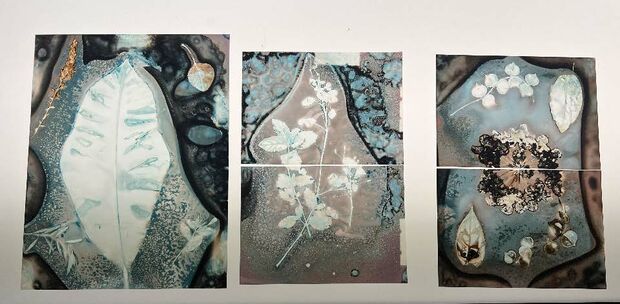Students Bring the Garden into the Art and Science of Photography

Tucked away at the base of the plate-glass facade in the Tyler Atrium, a series of photographic images were ever so slowly coming into view.
The eclectic collection of anthotypes, chlorophyll prints and phytograms was a project in Adjunct Professor Laurie Beck Peterson’s plant-based photography class this fall, and they relied on the fickle nature yet ubiquitous presence of natural light to appear.
“The purpose of teaching these techniques is to promote sustainability and reduce the environmental impact of hazardous photography chemical waste,” Petersen explained during the fall semester. “Students learn skills that align with current trends in sustainability, which they can then incorporate in their artwork.”
Harvesting plant life
Peterson’s students harvested plant material they sourced independently as well as from the Fibers and Material Studies’ dye garden in the Tyler Courtyard and during a class trip to the greenhouse on Temple’s Ambler campus.
They also had the advantage of personal hydroponic gardens, placed around the Tyler building, as an alternative source of plant materials once the seasons change. In those gardens, donated by the company Rise Gardens, they grew pea flowers, beets, red cabbage, dandelions, mint and basil, among other leafy green plants.
Peterson, who views what she’s teaching as a true blend of art and science, said the students gained “an understanding of gardening and stewardship with their plant choices,” growing plants such as butterfly pea flowers, Chiogga beets, red cabbage, amaranth and dandelions for making anthotypes, an image created using photosensitive material from plants under the influence of light.
Students grew mint and basil to mix plant-based developers for creating phytograms, a technique that uses the internal chemistry of plants for the creation of images on photographic emulsion. They learned they could process film using essentially any base that contain phenols, an organic compound found in fruits, vegetables, grains, legumes, spices, and even combinations of wine, beer, and tea.


Creating resources and guides
The students compiled documentation of their work and notes on the various processes, and Sophia Dell’Arciprete (MFA '25), a Photography graduate teaching assistant, completed a clothbound book that contains handwritten data and instructions along with photographs to be used as a process guide by future students. Ultimately, they would like to provide Tyler Horticulture Adjunct Professor Ben Snyder with enough plant information to create an “Arboretum Explorer” database, from which a self-guided online tour of plants sourced from the arboretum could be used by other students for photo processing.
About 14 students enrolled in the fall course, 25 percent of which were non-Tyler students. They worked in pairs to care for the indoor gardens, watering, adding nutrients and eventually harvesting plants. The class was also required to read Braiding Sweetgrass, Indigenous Wisdom, Scientific Knowledge, and the Teachings of Plants by Native American botanist Robin Wall Kimmerer.


Trusting the process
Tyler Goodwin, a senior journalism major at the Klein College of Media and Communications, said what intrigued him most about the class was the ability to reconnect with some elements of the photographic process, which took several days or weeks for images to reveal themselves.
“Nowadays with the instant access we all have to taking a photo, it’s hard to connect with your subject matter. Adding the plant-based aspect back in helps me keep an active role in my photo-making process,” said Goodwin. “There are constant challenges within plant-based photography, but in many ways that is the best part of it all. It is very freeing to return to a process that relies so heavily on you being present with input and methodology.”
Classmate Samra Bowser, a senior Psychology major in the College of Liberal Arts, said she felt very grounded working through the processes in Peterson’s class. “I love how it brings us back to the point that existing life on earth is art and reminds us about our natural connection to the earth. It makes me feel more connected to the world around me,” said Bowser. She added that her biggest challenge was having patience. “Certain processes take longer and require more attention which can be hard to remember,” she confessed.
Bowser experimented with a kind of collaging, layering negatives along with plant material. “I think this could look cool with the natural colors of plant emulsions, or different hues from expired film,” she said. “What I try and do through my work, when there are multiple parts, is to have everything seem like it was always supposed to be together. Even with placing specific plants together, I want to convey a story of connectedness and familiarity.”


Lure of the ephemeral
Tyler second-year Printmaking graduate student Rae Helms (MFA '25) said what fascinated them about the course was “the ephemeral nature of these materials and the time-based processes involved. The unique aspect that captivates me is that these materials have a life of their own.”
“For instance, certain processes continue to evolve or transform as they interact with the environment. In my work, I am constantly exploring how places and sites undergo change and how the weather influences materiality, land, and time.”
Peterson, who also works in 19th-century photo processes and whose own work in gum bichromate, cyanotype and platinum palladium reflects other “slow art” photographic approaches, expects to offer the course every fall semester.